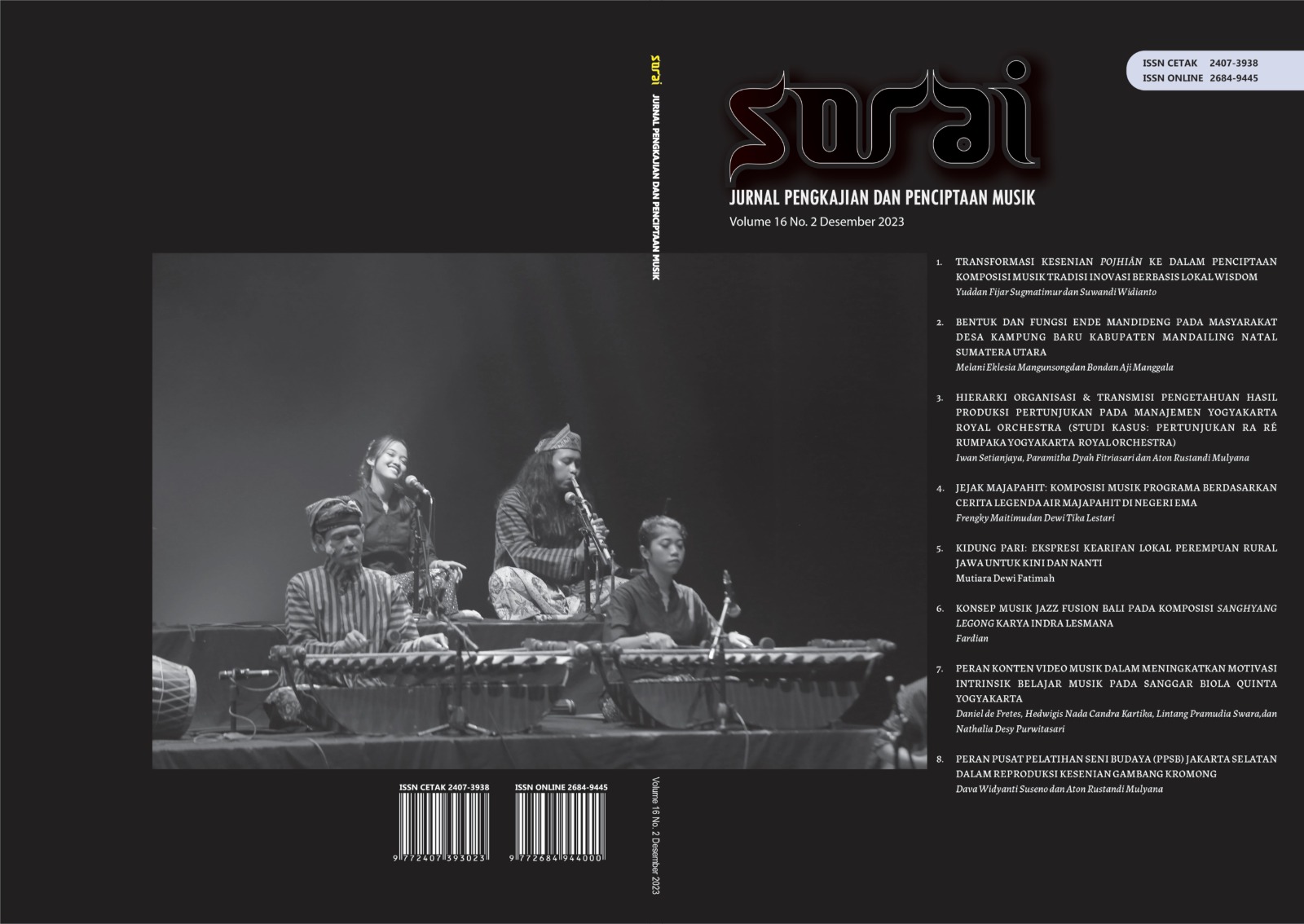KIDUNG PARI: EKSPRESI KEARIFAN LOKAL PEREMPUAN RURAL JAWA UNTUK KINI DAN NANTI
Main Article Content
Abstract
The concept of the Kidung Pari work broadly draws inspiration from the role of rural Javanese women in farming activities, starting from pre-production, farming production, post-production, to activities outside the agricultural space, such as ngliwet or cooking rice. By drawing inspiration from each detail of these activities, positive values about the attitudes and roles of Javanese women in their social environment will become apparent. Although women’s roles in these activities may appear as “rough labor,” their involvement is significant in almost every stage of farming, from the rice fields to the kitchen. Through the composition of the Kidung Pari music, it will reveal another aspect of women, who are generally known for being gentle, beautiful, emotional, and nurturing. This community empowerment project through the arts is an effort to explore the intrinsic values and local knowledge possessed by the residents, as well as the development of existing traditional art potential as a means of preservation, education, and promotion of the region’s untapped potential. The activities to be carried out in this program include collaborative practices in visual arts and performing arts, including training in Karawitan for the mothers of the Tani Makmur group in Tawangrejo Village, and the results of this training will be showcased. The Kidung Pari work is an endeavor to immortalize the story of rural Javanese women in history, culture, society, worldview, and self-reflection in Javanese society. Through the Kidung Pari work, Indonesia needs to explore and develop new values to elevate the status of rural Javanese women, making them more superior, resilient, and empowered in the present and future.
Downloads
Article Details

This work is licensed under a Creative Commons Attribution-ShareAlike 4.0 International License.
Copyright
Authors who publish to Sorai: Jurnal Pengkajian dan Penciptaan Musik agrees to the following terms:
- Authors retain copyright and grant the journal right of first publication with the work simultaneously licensed under a Creative Commons Attribution License (CC BY-SA 4.0) that allows others to share the work with an acknowledgment of the work's authorship and initial publication in this journal.
- Authors can enter into separate, additional contractual arrangements for the non-exclusive distribution of the journal's published version of the work (e.g., post it to an institutional repository or edit it in a book), with an acknowledgment of its initial publication in this journal.
- Authors are permitted and encouraged to post their work online (e.g., in institutional repositories or on their website) before and during the submission process, as it can lead to productive exchanges, as well as earlier and greater citation of published work.
References
Alir, D. (n.d.). Metodelogi penelitian. 20–28.
Antara, M., Pertanian, F., Udayana, U., Visual, D. K., Tinggi, S., & Bali, D. (2018). KERAGAMAN BUDAYA INDONESIA SUMBER INSPIRASI. 292–301.
Ayu, A. R., Tinggi, S., & Manajemen, I. (2022). Peran perempuan dalam ekonomi. 26–31.
D Budiono, S. Ha. (2019). Empowering Rural Women in Indonesia through Cultural Preservation: A Case Study of Traditional Songs in Yogyakarta. Journal of Rural and Community Development, 1, 53–68.
Helmi, S. (2021). Analisis data (Issue July). Ika, B. T., Chaubet, D. F., Barat, J., Intangible, T., Herritage, C., Barat, J., Belanda, H., Sri, D., & Padi, D. (2015). BAB I PENDAHULUAN Latar Belakang. 1–9.
Indonesia, D. (2009). BAB I. 1–73.
R.D Hapsari. (2020). The Role of Women in the Preservation of Javanese Oral Tradition. Jurnal Perempuan, 2, 184–196.
S. Setyaningsih. (2021). The Resilience of Javanese Rural Women: Cultural Preservation and Women’s Empowerment. International Journal of Gender and Women’s Studies, 1, 120–135.
S Hardjosuwignyo. (2016). Cultural Wisdom as a Foundation for Women’s Empowerment in Javanese Rural Communities. Journal of Women’s Studies, 3.
Santosa, R. (2018). Women’s Roles in Javanese Rural Communities: A Study of Gendered Cultural Practices. Journal of Southeast Asian Studies, 264–287.
Sanyoto, S., Harini, N., & Zandra, R. (2019). Gending Lesung Jumengglung. Jurnal Imaji, 17(c), 171–178.
Sugiyono. (2015). metode pembelajaran pendekatan kuantitatif dan kualitatif. Alfabet
